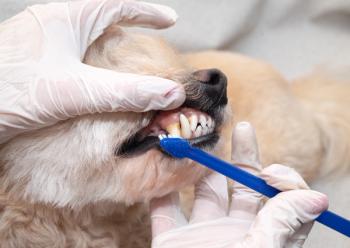
Periodontal disease in cats: Current best practices for diagnosis, treatment and prevention
There are 4 broad classifications of periodontal disease in cats diagnosed using clinical appearance, probing, and intraoral radiography. Recommended therapy is based on the diagnosed stage and understanding that once early periodontitis is diagnosed, the disease is progressive.
Stage 1 (PD1) Periodontal Disease: Gingivitis- Inflammation of the Gingiva Without Support Loss
Gingivitis is the initial stage of periodontal disease. Inflammation is limited to the gingival soft tissues and does not extend into the tooth’s support structures (alveolar bone, periodontal ligament, and cementum). The height and architecture of the alveolar margin are normal. Gingivitis can be present without periodontitis. Periodontal disease cannot exist without gingivitis unless it is in an area of previous periodontitis that has been treated and controlled, relieving inflammation but not attachment loss. The goals of therapy in treating gingivitis include removing irritants and debris from the tooth surfaces and sulci and eventually returning the inflamed area(s) to normal using continued plaque control at home. This is accomplished through dental scaling, polishing and irrigation along with homecare.
Stage 2 (PD2) Periodontal Disease: Early Periodontitis
Early periodontal disease is diagnosed when up to 25% of attachment loss is present or, at most, there is stage 1 furcation involvement diagnosed in a multi-rooted tooth. The loss of periodontal attachment is measured by probing the clinical attachment level along with the radiographic determination of bone loss measured from the cementoenamel junction to the base of bone loss relative to the length of the root.
Periodontal therapy for stage 2 early periodontitis includes removing irritants and debris from the tooth surfaces and the periodontal pocket(s) through subgingival and supragingival dental scaling, irrigation and polishing. Bleeding on probing and stage 2 cleaned pockets can be treated by local antibiotic application (LAA). The antibiotic reduces the bacterial load thus reducing inflammation.
Gingival Recession: Periodontal disease without pockets
Gingival recession results in the exposure of the root surface. The gingiva migrates apical to and often past the cementoenamel junction. The periodontal attachment level (PAL) is an accurate measurement of periodontal destruction in cases of gingival recession where little or no pocketing exists. The PAL is measured from the base of the gingival sulcus/periodontal pocket to the cementoenamel junction. When gingival recession results in loss of the attached gingival collar around the tooth, further recession is unavoidable, as mucosa cannot withstand chewing forces.
Treatment of Minimal Gingival Recession
In cases of stages 1 and 2 periodontal disease, usually no additional treatment is indicated after dental scaling, polishing and irrigation, provided a healthy collar of at least 2 mm of attached gingiva remains. Stringent daily home care including tooth brushing is recommended to reduce progression of support loss.
Stage 3 (PD3) Periodontal Disease: Moderate Periodontitis
Moderate periodontal disease is diagnosed when there is 25 to 50% attachment loss as measured either by probing the clinical attachment level or by radiographic determination of bone loss measured from the cementoenamel junction to the base of the bone loss relative to the length of the root. Often there is stage 2 furcation involvement in multi-rooted teeth.
Placement of a local antibiotic (LAA) into a cleaned pocket can help heal periodontal tissues and may in time significantly reduce the pocket depth. Root planing may produce the same result without the application of local antimicrobials. Extraction of the affected tooth is recommended in cases where plaque control will not be performed.
Stage 4 Periodontal Disease (PD4): Advanced Periodontitis
Stage 4 advanced periodontitis is diagnosed when more than 50% attachment loss exists as evidenced by probing of the clinical attachment level, by intraoral radiographic determination, or when there is a stage 3 furcation involvement in multi-rooted teeth.
In cases of moderate and advanced periodontal disease, surgery is usually indicated to extract teeth in the following situations; where there is stage 3 mobility, or where teeth are fractured with pulp exposure, have furcation exposure, or the client is unable or unwilling to control plaque.
Normally, the alveolar margin is positioned within 1 mm apical to the cementoenamel junction. Occasionally, when the maxillary or mandibular canine teeth are affected by advanced periodontal disease, there is increased clinical‐appearing crown height compared to the contralateral unaffected tooth. This condition is called canine tooth extrusion or super eruption. It has been reported that a significant relationship exists between super eruption and tooth resorption. Treatment of choice for tooth extrusion is extraction
About Basepaws
Basepaws is a leading innovator in pet biotechnology and is committed to research and discovering new knowledge that will help veterinary professionals provide better care for their patients. Basepaws helps veterinary professionals to set standards for health and wellness and provides the necessary tools to empower proactive health interventions and true preventative healthcare. In their mission to bring more pets to the veterinarian for proactive care, they’ve developed an
Newsletter
From exam room tips to practice management insights, get trusted veterinary news delivered straight to your inbox—subscribe to dvm360.





